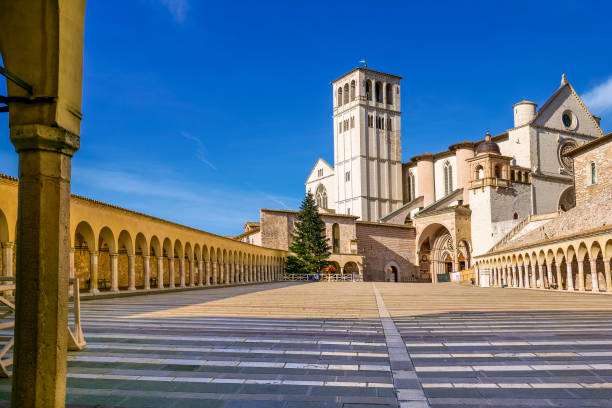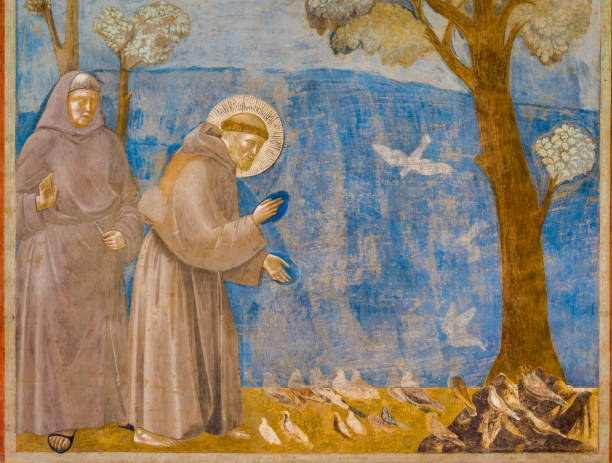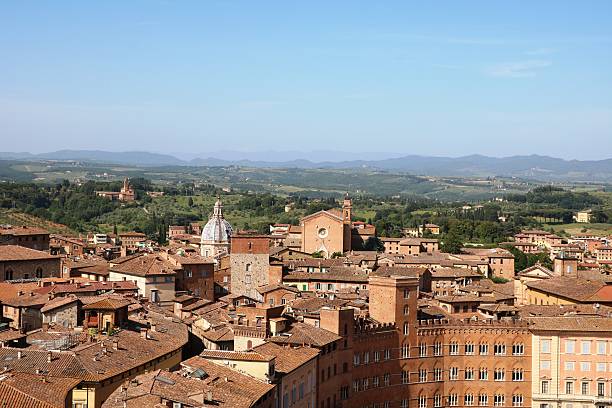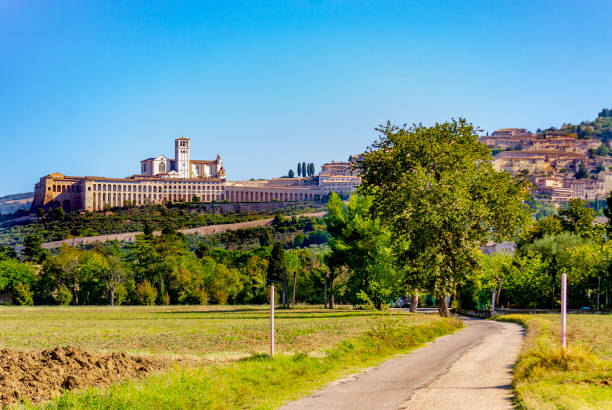
Basilica Of San Francisco Assisi Pictures, Images and Stock Photos
Browse 430+ basilica of san francisco assisi stock photos and images available, or start a new search to explore more stock photos and images.

Front view of the famous Basilica of St Francis, Assisi, Italy
The Basilica of San Francesco is the most famous landmark of Assisi, and one of the most important places of Christian pilgrimage in Italy. Its built began in 1228, and now comprises two churches known as the Upper Church and the Lower Church, decorated with frescoes by important medieval painters such as Cimabue and Giotto. The crypt preserves the remains of the saint. The Basilica has been a UNESCO World Heritage Site since 2000. Assisi, Italy.
The Basilica of Saint Francis of Assisi is in a town in the Umbria region, where Saint Francis was born and died.
A wide angle scene of the Lower Square of the Basilica di San Francesco (Basilica of St Francis) in the medieval town of Assisi, in Umbria. On the center, the bell tower and the facade in Italian Gothic style of the Basilica dedicated to the Saint of the Poor. Built in the Italian Gothic style starting from 1228 and completed in 1253, the Basilica, which preserves the mortal remains of the Saint of the Poor from 1230, is composed of the Basilica Inferiore (Lower Basilica) and the Basilica Superiore (Upper Basilica), perfectly integrated. Over the centuries Assisi and the spirituality of its sacred places have become a symbol of peace, a point of reference for tolerance and solidarity between peoples and between the different confessions of the world. The Umbria region, considered the green lung of Italy for its wooded mountains, is characterized by a perfect integration between nature and the presence of man, in a context of environmental sustainability and healthy life. In addition to its immense artistic and historical heritage, Umbria is famous for its food and wine production and for the high quality of the olive oil produced in these lands. Since 2000 the Basilica and other Franciscan sites of Assisi have been declared a World Heritage Site by UNESCO. Image in high definition format.
View towards the famous Basilica of St Francis, Assisi, Italy
Basilica of San Francesco, Assisi - Italy
A splendid landscape of the green Umbria Valley with in the foreground the Basilica Superiore di San Francesco (Upper Basilica of St Francis), the Sacro Convento (the Franciscan Monastery) and a glimpse of the medieval town of Assisi. Built in the Italian Gothic style starting from 1228 and completed in 1253, the Basilica, which preserves the mortal remains of the Saint of the Poor from 1230, is composed of the Basilica Inferiore (Lower Basilica) and the Basilica Superiore (Upper Basilica), perfectly integrated. Over the centuries Assisi and the spirituality of its sacred places have become a symbol of peace, a point of reference for tolerance and solidarity between peoples and between the different confessions of the world. The Umbria region, considered the green lung of Italy for its wooded mountains, is characterized by a perfect integration between nature and the presence of man, in a context of environmental sustainability and healthy life. In addition to its immense artistic and historical heritage, Umbria is famous for its food and wine production and for the high quality of the olive oil produced in these lands. Since 2000 the Basilica and other Franciscan sites of Assisi have been declared a World Heritage Site by UNESCO. Image in high definition format.
The beautiful fresco painted by Giotto depicting Saint Francis talking to birds inside the Basilica Superiore di San Francesco (Upper Basilica of Saint Francis), in the medieval heart of Assisi, in Umbria. Giotto painted a series of great frescoes along the walls of the single nave of the Basilica between 1292 and 1305, depicting the Stories of St. Francis, from his vocation to his death. Built in the Italian Gothic style starting from 1228 and completed in 1253, the Basilica preserves the mortal remains of the Saint of the Poor since 1230. The construction of the Basilica consists of a Lower Basilica and an Upper Basilica, perfectly integrated. Over the centuries Assisi and the spirituality of its sacred places have become a symbol of peace, a point of reference for tolerance and solidarity between peoples and between the different confessions of the world. The Umbria region, considered the green lung of Italy for its wooded mountains, is characterized by a perfect integration between nature and the presence of man, in a context of environmental sustainability and healthy life. In addition to its immense artistic and historical heritage, Umbria is famous for its food and wine production and for the high quality of the olive oil produced in these lands. Since 2000 the Basilica and other Franciscan sites of Assisi have been declared a World Heritage Site by UNESCO. Image in high definition format.
The Basilica of San Francesco is the most famous landmark of Assisi, and one of the most important places of Christian pilgrimage in Italy. Its built began in 1228, and now comprises two churches known as the Upper Church and the Lower Church, decorated with frescoes by important medieval painters such as Cimabue and Giotto. The crypt preserves the remains of the saint. The Basilica has been a UNESCO World Heritage Site since 2000. Assisi, Italy.
The basilica of St Francesco in Assisi, Italy.
Assisi is a town in the province of Perugia in the Umbria region, Italy.
Assisi, Italy
Historic Ouro Preto in the sunlight
"Assisi cityscape, Umbria Italy-MORE photos from ASSISI:"
"Beautiful Italian Landscape With The City Of Assisi, Italy."
A beautiful and peaceful landscape with the Basilica di San Francesco (Basilica of St Francis) in the medieval town of Assisi, in Umbria, surrounded by olive trees and Italian cypresses. Built in the Italian Gothic style starting from 1228 and completed in 1253, the Basilica, which preserves the mortal remains of the Saint of the Poor from 1230, is composed of the Basilica Inferiore (Lower Basilica) and the Basilica Superiore (Upper Basilica), perfectly integrated. Over the centuries Assisi and the spirituality of its sacred places have become a symbol of peace, a point of reference for tolerance and solidarity between peoples and between the different confessions of the world. The Umbria region, considered the green lung of Italy for its wooded mountains, is characterized by a perfect integration between nature and the presence of man, in a context of environmental sustainability and healthy life. In addition to its immense artistic and historical heritage, Umbria is famous for its food and wine production and for the high quality of the olive oil produced in these lands. Since 2000 the Basilica and other Franciscan sites of Assisi have been declared a World Heritage Site by UNESCO. Super wide angle image in high definition quality.
Assisi, Umbria, Italy, May 04 -- A beautiful and peaceful panorama of the Basilica di San Francesco (Basilica of St Francis) in the medieval town of Assisi, in Umbria, surrounded by olive trees and Italian cypresses. Built in the Italian Gothic style starting from 1228 and completed in 1253, the Basilica, which preserves the mortal remains of the Saint of the Poor from 1230, is composed of the Basilica Inferiore (Lower Basilica) and the Basilica Superiore (Upper Basilica), perfectly integrated. Over the centuries Assisi and the spirituality of its sacred places have become a symbol of peace, a point of reference for tolerance and solidarity between peoples and between the different confessions of the world. The Umbria region, considered the green lung of Italy for its wooded mountains, is characterized by a perfect integration between nature and the presence of man, in a context of environmental sustainability and healthy life. In addition to its immense artistic and historical heritage, Umbria is famous for its food and wine production and for the high quality of the olive oil produced in these lands. Since 2000 the Basilica and other Franciscan sites of Assisi have been declared a World Heritage Site by UNESCO. Super wide angle image in high definition quality.
Sketching Historical Architecture in Italy: Assisi. Illustration is in eps8 vector mode!
Ravenna, Italy - Sept 11, 2019: The Basilica of San Francesco in Ravenna. Emilia-Romagna, Italy
Assisi, Italy
The detail of a fresco by Cimabue inside the Basilica Inferiore di San Francesco (Upper Basilica of San Francesco), in the medieval heart of Assisi, in Umbria. Built in the Italian Gothic style starting from 1228 and completed in 1253, the Basilica preserves the mortal remains of the Saint of the Poor since 1230. The construction of the Basilica consists of a Lower Basilica and an Upper Basilica, perfectly integrated. Over the centuries Assisi and the spirituality of its sacred places have become a symbol of peace, a point of reference for tolerance and solidarity between peoples and between the different confessions of the world. The Umbria region, considered the green lung of Italy for its wooded mountains, is characterized by a perfect integration between nature and the presence of man, in a context of environmental sustainability and healthy life. In addition to its immense artistic and historical heritage, Umbria is famous for its food and wine production and for the high quality of the olive oil produced in these lands. Since 2000 the Basilica and other Franciscan sites of Assisi have been declared a World Heritage Site by UNESCO. Image in high definition format.
View of Assisi
La magia di Assisi
Assisi, Italy, Aug. 2021 - Exterior of the Basilica of Saint Francis of Assisi (upper Basilica), one of the most important tourist destinations in Italy and UNESCO World Heritage Site
The detail of the figure of Saint Francis in one of the magnificent frescoes painted by Giotto inside the Basilica Superiore di San Francesco (Upper Basilica of Saint Francis), in the medieval heart of Assisi, in Umbria. Giotto painted a series of great frescoes along the walls of the single nave of the Basilica between 1292 and 1305, depicting the Stories of St. Francis, from his vocation to his death. Built in the Italian Gothic style starting from 1228 and completed in 1253, the Basilica, which preserves the mortal remains of the Saint of the Poor from 1230, is composed of the Basilica Inferiore (Lower Basilica) and the Basilica Superiore (Upper Basilica), perfectly integrated. Over the centuries Assisi and the spirituality of its sacred places have become a symbol of peace, a point of reference for tolerance and solidarity between peoples and between the different confessions of the world. The Umbria region, considered the green lung of Italy for its wooded mountains, is characterized by a perfect integration between nature and the presence of man, in a context of environmental sustainability and healthy life. In addition to its immense artistic and historical heritage, Umbria is famous for its food and wine production and for the high quality of the olive oil produced in these lands. Since 2000 the Basilica and other Franciscan sites of Assisi have been declared a World Heritage Site by UNESCO. Image in high definition format.
Assisi, Italy - October 14, 2013: The Upper Church of the Basilica di San Francesco at dusk. The Basilica is the most famous landmark of Assisi, and one of the most important places of Christian pilgrimage in Italy. The bronze statue "Pellegrino di pace", Pilgrim of peace, located in front of the church, is dedicated to St Francis and is an artwork of Norberto Proietti (1927-2009) dated 2005.
A suggestive landscape of the medieval town of Assisi, in Umbria, central Italy. On the left the Basilica di San Francesco (Basilica of Saint Francis) and the Sacro Convento (Sacred Abbey) of the Franciscan friars. An ancient Umbrian city built starting from the 9th century BC, Assisi became in 89 BC an important center of social and economic domination of Ancient Rome. After the fall of Rome and countless looting due to the barbarian invasions, in the Middle Ages Assisi was conquered by the Byzantines and the Lombards, finally ending up under the dominion of the emperor Frederick I the Barbarossa. Assisi is famous for being the city of San Francesco and Santa Chiara (Saint Francis and Saint Clare), a sacred and spiritual place, a world symbol of peace between all the peoples of the earth and the different confessions. The Umbria region, considered the green lung of Italy for its wooded mountains, is characterized by a perfect integration between nature and the presence of man, in a context of environmental sustainability and healthy life. In addition to its immense artistic and historical heritage, Umbria is famous for its food and wine production and for the quality of the olive oil produced in these lands. Since 2000 the Basilica and other Franciscan sites of Assisi have been declared a World Heritage Site by UNESCO. Image in 16:9 and high definition format.
Basilica of San Francesco d'Assisi, Umbria Italy
Panorama of Assisi (Italy) with Saint Francis Cathedral
Life-size statues recreate the atmosphere of the Nativity scene in front of the Basilica of St. Francis in Assisi, during the Christmas celebrations. Tourists visiting.
Saint Francis Cathedral in Assisi, Italy
The Saint Francis Basilica or Upper Church in Assisi, Italy
The magnificent frescoed interior of the Basilica di San Francesco (Basilica of Saint Francis), in the medieval heart of Assisi, in Umbria. In the image, the transept and the central nave seen behind the high altar inside the Basilica Inferiore, with frescos by Giotto, Cimabue and Pietro Lorenzetti. Built in the Italian Gothic style starting from 1228 and completed in 1253, the Basilica, which preserves the mortal remains of the Saint of the Poor from 1230, is composed of the Basilica Inferiore (Lower Basilica) and the Basilica Superiore (Upper Basilica), perfectly integrated. Famous for being the homeland of St. Francis and St. Clare, over the centuries Assisi and the spirituality of its sacred places have become a symbol of peace, a point of reference for tolerance and solidarity between peoples and between the different confessions of the world. The Umbria region, considered the green lung of Italy for its wooded mountains, is characterized by a perfect integration between nature and the presence of man, in a context of environmental sustainability and healthy life. In addition to its immense artistic and historical heritage, Umbria is famous for its food and wine production and for the high quality of the olive oil produced in these lands. Since 2000, the Basilica and the other Franciscan places in Assisi have been declared a World Heritage Site by UNESCO. Wide angle image in high definition quality.
View to Piazza del Campo to Basilica di San Francesco in Siena, Tuscany Italy
ASSISI, PERUGIA, UMBRIA, ITALY - September 30, 2018: Panorama of the Basilica of the Sacro Convento di San Francesco, a World Heritage Site
The Basilica of St. Francis in Assisi, Italy.
The City Of Assisi In Italy
View of the famous Basilica of St Francis, Assisi, Italy
The Basilica di San Francesco is the most famous landmark of Assisi, and one of the most important places of Christian pilgrimage in Italy. The bronze statue 'Pellegrino di pace', Pilgrim of peace, located in front of the church, is dedicated to St Francis and is an artwork of Norberto Proietti (1927-2009) dated 2005.
A large Nativity scene with a nearby Christmas tree celebrate the advent in Assisi, the birthplace of St. Francis and one of the most popular religious destinations in Italy. People.
Assisi (Umbria) Basilica of San Francesco
Beautiful sunset landscape, view from Basilica of San Francisco,Assisi, Umbria, Italy, Europe
Ascoli Piceno, Italy - August 19, 2019: A view of Piazza del Popolo square with some café tables and the Chiesa di San Francesco basilica church

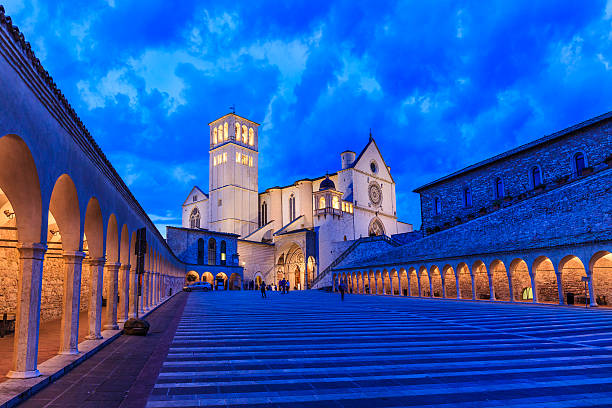
![[Italy] Basilica of St. Francis of Assisi The Basilica of Saint Francis of Assisi is in a town in the Umbria region, where Saint Francis was born and died. basilica of san francisco assisi stock pictures, royalty-free photos & images](https://media.istockphoto.com/id/1470337038/photo/italy-basilica-of-st-francis-of-assisi.jpg?s=612x612&w=0&k=20&c=0p-ClKz545rypc8JwCogXzupSt2CIu5rDluKVR0jzX8=)
